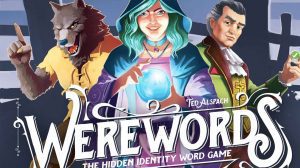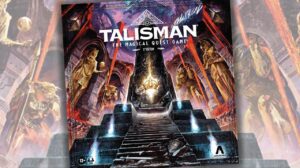This is probably one of the most subjective topics in tabletop blogging, but it also allows the audience (such as yourself) to discover some hidden games in a sea of painted cardboard and plastic dolls. Hobbyists are always looking for something new to play and try out, but sometimes “new” isn’t all that new.
We are going to take a look at 9 underrated games out there in my 100% objective opinion. Some of these are still in print, while others might be a bit more challenging to find. These are not perfect games, so we are going to look at what makes them work and examine the blemishes.

Tyrants of the Underdark
Released in 2016, this hybrid was one of the few games at the time that successfully combined the use of its board and a deckbuilding system. You played as one of the four houses vying for control of the Underdark. Think “Game of Thrones” except everyone is a Lannister. Not only did this introduce area control and diplomacy to deckbuilding, but it allowed numerous ways to score points. It was a point salad before the term was invented. You can score points by controlling major cities, slaying armies, and shredding your deck. So what happened?
The game’s production was a bit of a nightmare for color-blind players. The component’s colors mixed with the board’s colors thus scrawling a recipe for disaster. The final nail on the coffin was the first expansion. It added two more mini decks to the base game’s four mini decks. Mechanically, they were great additions but were pinned down by quality control issues. The printing quality was not nearly as consistent as the original game as they had a different finish and thickness. Any further support of the game died after that.
You can buy this game at Amazon US

Blood Bound
This game is a perfect example of the importance of first impressions. This vampire social deduction game’s first printing had all of its visuals based on photography with a renaissance costume group. The costume design and photos were good, but it doesn’t look right when slapped onto cardboard. Board gamers expect artwork, not photographs.
The second printing replaced everything with custom artwork while maintaining the exact same rules, but the damage was already done. It’s unfortunate because in a genre of social deduction games, the rules on this one stick out like a wooden stake in a chest. There is no night phase, and it didn’t follow the typical Werewolf formula. It was a game of two teams, and each player assigned a numbered “rank” with a special power associated with that rank.
Your job is to murder the other team’s leader, and you are going to do that by stabbing people. The type of wound they bleed out slowly gives you some information on what team and rank that player might be. Once a player gets 4 wounds, they die, and the game ends. If they were the rival leader, you win, but if they weren’t, your team loses. To make the puzzle more challenging, you also had to overcome player powers, items, and status effects. It is a game too heavy for the typical social deduction crowd, but too light for the gamer crowd. It’s a weird middle ground for people like me, and I honestly think it’s a game that could use a bit more attention.
You can buy Blood Bound at Amazon US

Bloodborne The Card Game
I don’t know if this is cheating because I did write a review on it. Eric Lang is a well-known designer with mixed results regarding his games. I’ll admit that I got more misses than hits with his work, but when it hits, it leaves a feeling that doesn’t go away. In Bloodborne the Card Game’s case, it’s a game that does a lot right in a small package.
The base game had a good idea but no content to support those ideas, hence the reason for its lukewarm response from several reviewers. Many fans of the Bloodborne series also didn’t like how the game flowed, and the objective didn’t make sense in relation to the intellectual property. Since I grew up playing board games made by German game designers, I’m used to themes being little more than wallpaper for the game’s rules.
The strengths of this underrated title mainly come from the Hunter’s Nightmare expansion. The expansion, which is probably one of the cheapest expansions in board gaming, introduces new rules that can be explained in a few sentences and content to juice up the game. Outside of the theme issue, it fixes most of the complaints reviewers had with the base game.
It’s 45 minutes of semi-cooperative dungeon crawling with numerous layers to solve. You have drafting, bluffing, diplomacy, risk management, hand management, and hand building. All of these ideas are communicated through a very simple ruleset. Throw in sensible production quality, and you have an enjoyable game.
You can buy Bloodborne: Card Game at Amazon US

Eternal: Chronicles of the Throne
Now I know I’m cheating because I did write a review on this one as well. I haven’t played a good PvP deckbuilder until Eternals. Yes, I did play Nightfall and Arctic Scavengers. Yes, I also played Star Realms and Shards of Infinity. None of the games felt as engaging as Eternals.
Why is that the case? Eternals is the closest thing you’ll get to Keyforge, Yugioh, or Magic the Gathering in deckbuilder clothes. It emulates the collectible card game decisions such as what creatures to block or attack with, or what artifacts and spells to use to counter your opponent. Combine this with a drafting system very similar to Ascension, and you have a fantastic 30 minute game.
So…what happened? Bad timing. It was released years after games like Shards of Infinity and Star Realms were out, where PvP deckbuilder interest was high. Another problem is some players complaining about luck, which confuses me because deckbuilders always have luck in them. It’s like complaining about your car needing gas. It also could’ve scaled a bit better with higher player counts since it was a free for all with player elimination. Either way, I think anyone looking for a good PvP deckbuilder with a seasoning of Magic should check this one out.
You can buy Eternal: Chronicles of the Throne at Amazon US

Eminent Domain
We are digging a fossil now. Eminent Domain was one of Tasty Minstrel Games’ first games to be released by the company, and it was a Kickstarter. Unlike Kickstarters of today, this one was a sensible project. No funny plastic dolls, a bazillion stretch goals, or anything crazy. It was a card game with the only Kickstarter extras being a fancy looking box and a few cards.
It is a sci-fi deckbuilder with dipped in a role selection dressing. Instead of buying cards, you would select a Role that gives you a particular action to do and gain that role card. For example, if you picked Warfare, you would either conquer a planet or get a ship. However, selecting that role means you take the Warfare card from the middle stack and add to your deck. You can boost this action by playing Warfare cards from your hand. While that sounds good, it gets more interesting because other players can also join in on your action if they have a Warfare card in their hands.
Much like Bloodborne, this game has a good concept but not much else. The game was established when the Escalation expansion was released. The expansion made some sweeping changes to the core structure and added some highly requested content like asymmetrical starting decks. Another roadblock to this game’s success was the Technology deck. By performing the Research action, players are required to dig through the Technology deck. It was a daunting task for new players since they had to rummage through dozens of cards to devise a plan. It puked complexity on a simple game.
Funny enough, it is still getting expansions to this day, but it remains in this weird purgatory state where nobody talks about this game despite being supported by the publisher. It deserves better.
You can buy Eminent Domain at Amazon US

Fairy Tale
This is probably the most controversial item on the list. Some people don’t like this game at all, and you have clowns like me who think this game does the whole “drafting” thing better than games like Sushi Go and 7 Wonders.
What makes this game stand apart is the game play elements outside of drafting. You draft to get five cards in your hand, then you play three cards out of five, one card at a time, to add to your tableau. This is important because it promotes hate drafting, a strategy not used enough in today’s drafting games. “Hate Drafting” is drafting cards not for your benefit, but to hinder other players. In games like 7 Wonders, this is a bad idea because drafting for your own sake was far more productive than hate drafting. In Fairy Tales, the decision is more balanced.
Unfortunately, Fairy Tales suffer from various issues that barricade its success. It can be vicious as some cards would destroy other player’s cards if timed properly. The graphical design of the cards are not newbie-friendly as the card layout and iconography were hard to comprehend. Player scaling did not work because you didn’t go through the entire deck, meaning set collection was more luck-based at lower player counts. Speaking of set collection, explaining how they work was far more complicated than the simplicity of Sushi Go.
This is the most flawed game on the list, but it is still an underrated drafting game that takes about 20 minutes to play.

Sons of Anarchy
If you are looking for an out of print game that you can find for dirt cheap, this is your meal ticket. Sons of Anarchy is a worker placement with violence. Lots of violence.
What would you expect in a game where you control a biker gang? You want money, and people are in your way, so you will start brawls to kick them out. Unlike other worker placements, multiple players can hold a spot. The problem is you can only activate that spot when you are alone, not majority control. That’s where the fighting begins as players will count their members, roll some dice, and a people get pushed out. Throw in a diplomatic sprinkle where players can trade whatever resources they like at any time, and it sounds like a dish worth eating.
Since this is on the list, you know the story. Sadly, this was a result of awkward marketing. This game was released during a time where licensed games were viewed unfavorably, and biker gangs shooting each other or grabbing duffle bags of drugs didn’t mix well with the “family-friendly” image of the board game industry. In terms of mechanisms, unrestricted trading can lead to easy kingmaking, and there were small niggling issues with the game in a few areas. Despite that, this flawed game is still an underappreciated gem.

Dogs of War
This game was praised by various media outlets such as The Dice Tower and Shut Up & Sit Down. It is one of the most original games I have played while still retaining familiar mechanisms.
You are leading a mercenary group and several noble houses at war with each other. These noble houses have hidden ties to some players, including yourself, and it is your job to make sure your houses succeed. You will do this by sending your Captains to the front lines to win the battles. However, throughout the game, alliances can slowly shift as players will gain favor from the other houses as well to score points. All of this is done through simple worker placement mechanisms with a dash of area control thrown in for good measure. This game will demonstrate how badly you are at making decisions.
Unfortunately, overproduction and lack of expansions shot this game in the foot before heading to the races. This was a Kickstarter project, so overproduction was going to be a thing. The Captains were over-sized figures with large hats that often, pun intended, bumped heads with each other. This also meant that any sort of expansion would be pricey since they needed a separate mold for the Captains. No retail expansions were ever released, and the only expansions for this game were Kickstarter exclusives.
This is a big deal because the game’s replay value is low. Everyone starts with an asymmetrical power that pushed you into a very particular strategy. You went through the same arcs and tactics throughout every game, so having more powers would be beneficial, but it never happened. Throw in the poor playing scaling at lower players counts, and this game disappeared as quickly as it showed up like a poorly matched Tinder date. Perhaps in an alternative timeline, this game would’ve been highly successful.

Civilization: A New Dawn
This game is proof that board gamers can be a stubborn audience. Unlike previous Civilization games, you can complete this in about two hours or less with a game design aligning itself as an abstraction of civilization building.
One of the major highlights of the game was the use of the focus bar. You have five cards in a row that represents the five actions you can take. The idea behind it is the longer you take to play an action, the stronger the action will be when you execute the action. It created a dynamic puzzle for you to engage in while being surprisingly intuitive and easy to teach.
Since it took such a streamline philosophy to the game’s mechanisms, this alienated the core audience, and the general response was lukewarm. Many critics didn’t like the abstract approach and the use of the dice in combat since it gave them bad memories of playing Risk and Monopoly. To fans of the game, they also pointed out issues such as the end game objectives or the lack of any sense of discovery.
To be fair, some of the criticism is on point. There are occasions where the game would end in a very anti-climatic way due to how the objectives are handled. While the Focus bar and some of the rules are excellent, the game leaves a strange aftertaste that make it feel more like an area control game fronting itself as a civilization game.
There is a silver lining. There are rumors about an expansion coming out that contains several significant changes, including objectives, military, and discovery tokens. Perhaps when the expansion is confirmed, we might see renewed interest in this game.
You can purchase Civilization: A New Dawn at Amazon US











Excellent list! Your take on Civilization: A New Dawn is spot on, and that actually makes it an overrated game, rather than underrated. A game that needs an expansion (yet to be confirmed!) to be good is a broken game.
2022 update:
Tyrants has been re-released with the expansion included.
If you don’t like the theme of Sons of Anarchy, there’s also a D&D
version (Vault of Dragons) and a 1920s gangsters one (Wise Guys).
According to the folks at So Very Wrong About Games (who are also
fans of Dogs of War, Fairy Tale, and to some extent, Blood Bound),
the expansion for Civilization:AND really does improve it, and you should
play Dogs of War with the designer’s suggested variant (which you
can find in the Dog of War forum’s Variants section on BGG).
Another drafting game in which you’re not going to play everything you draft,
both because you may not be able to afford it and because you have limited
slots to put cards in, is Paper Tales, also liked by SVWAG.
The action system from Civ.:AND was copied by Ark Nova,
which went on to rank in BGG’s top 5. (There may have been
another game that used it, but I can’t seem to remember it.)
I forgot to mention that the new Tyrants also brought the price down a little (despite having more in the box).